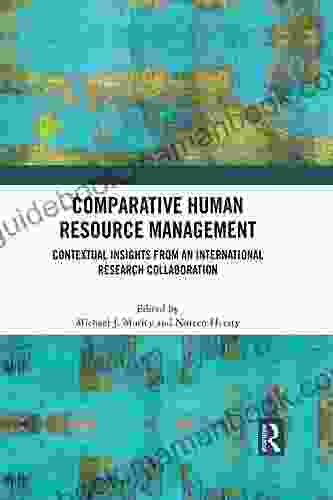Comparative Human Resource Management: A Comprehensive Guide to International HR Practices

Human resource management (HRM) is a field that is constantly evolving. As businesses become more globalized, HR professionals need to be able to manage employees from different cultures and backgrounds. Comparative human resource management (CHRM) is a field of study that examines the different ways in which HRM is practiced across countries.
CHRM is important because it helps HR professionals understand the different factors that affect employee behavior and motivation. By understanding the cultural, legal, and economic differences between countries, HR professionals can develop more effective HR policies and practices.
4.5 out of 5
| Language | : | English |
| File size | : | 1092 KB |
| Text-to-Speech | : | Enabled |
| Screen Reader | : | Supported |
| Enhanced typesetting | : | Enabled |
| Word Wise | : | Enabled |
| Print length | : | 199 pages |
The History of CHRM
The field of CHRM emerged in the early 1900s. At that time, businesses were beginning to expand their operations into new countries. HR professionals needed to find ways to manage employees from different cultures and backgrounds.
The first studies in CHRM focused on comparing the HRM practices of different countries. These studies revealed that there were significant differences in the way that HRM was practiced in different parts of the world.
In the 1960s and 1970s, the field of CHRM began to grow rapidly. This was due in part to the increasing globalization of businesses. Companies were now operating in more countries than ever before, and HR professionals needed to be able to manage employees from a variety of cultures.
Today, CHRM is a well-established field of study. There are a number of universities and colleges that offer degree programs in CHRM. In addition, there are a number of professional organizations that support CHRM research and practice.
The Benefits of CHRM
There are a number of benefits to studying CHRM. These benefits include:
- Increased understanding of employee behavior and motivation. By understanding the cultural, legal, and economic differences between countries, HR professionals can better understand the factors that affect employee behavior and motivation.
- Improved HR policies and practices. By learning from the experiences of other countries, HR professionals can develop more effective HR policies and practices. This can lead to improved employee productivity, morale, and retention.
- Increased competitive advantage. Companies that have a strong understanding of CHRM are better able to compete in the global marketplace. This is because they are able to attract and retain the best talent from around the world.
The Challenges of CHRM
There are also a number of challenges associated with CHRM. These challenges include:
- Cultural differences. One of the biggest challenges of CHRM is dealing with cultural differences. HR professionals need to be able to understand and accommodate the cultural differences of their employees. This can be a difficult task, especially in companies that have employees from a variety of cultures.
- Legal differences. Another challenge of CHRM is dealing with legal differences. HR professionals need to be aware of the labor laws and regulations of the countries in which they operate. This can be a complex task, especially in countries with different legal systems.
- Economic differences. Economic differences can also be a challenge for CHRM. HR professionals need to be able to develop HR policies and practices that are appropriate for the economic conditions of the countries in which they operate.
The Future of CHRM
The future of CHRM is bright. As businesses become more globalized, the need for HR professionals with a strong understanding of CHRM will only increase. HR professionals who are able to effectively manage employees from different cultures and backgrounds will be in high demand.
There are a number of trends that are shaping the future of CHRM. These trends include:
- The increasing globalization of businesses. As businesses become more globalized, the need for HR professionals with a strong understanding of CHRM will only increase. This is because companies will need to be able to attract and retain the best talent from around the world.
- The changing nature of work. The changing nature of work is also having a significant impact on CHRM. The rise of the gig economy and the increasing number of remote workers are forcing HR professionals to rethink the way they manage employees.
- The use of technology. Technology is also playing a increasingly important role in CHRM. HR professionals are using technology to automate tasks, improve communication, and track employee performance.
CHRM is a complex and challenging field, but it is also a rewarding one. By understanding the cultural, legal, and economic differences between countries, HR professionals can develop more effective HR policies and practices. This can lead to improved employee productivity, morale, and retention. As businesses become more globalized, the need for HR professionals with a strong understanding of CHRM will only increase.
References
- Society for Human Resource Management
- The Balance Careers
- National Library of Medicine
Image Alt Text
Comparative human resource management is the study of how human resource management practices vary across different countries. This can include differences in the way that employees are recruited, hired, trained, and compensated. It can also include differences in the way that labor unions are organized and the way that employee relations are handled. Comparative human resource management can be a valuable tool for HR professionals who are working in a global business environment.
4.5 out of 5
| Language | : | English |
| File size | : | 1092 KB |
| Text-to-Speech | : | Enabled |
| Screen Reader | : | Supported |
| Enhanced typesetting | : | Enabled |
| Word Wise | : | Enabled |
| Print length | : | 199 pages |
Do you want to contribute by writing guest posts on this blog?
Please contact us and send us a resume of previous articles that you have written.
 Top Book
Top Book Novel
Novel Fiction
Fiction Nonfiction
Nonfiction Literature
Literature Paperback
Paperback Hardcover
Hardcover E-book
E-book Audiobook
Audiobook Bestseller
Bestseller Classic
Classic Mystery
Mystery Thriller
Thriller Romance
Romance Fantasy
Fantasy Science Fiction
Science Fiction Biography
Biography Memoir
Memoir Autobiography
Autobiography Poetry
Poetry Drama
Drama Historical Fiction
Historical Fiction Self-help
Self-help Young Adult
Young Adult Childrens Books
Childrens Books Graphic Novel
Graphic Novel Anthology
Anthology Series
Series Encyclopedia
Encyclopedia Reference
Reference Guidebook
Guidebook Textbook
Textbook Workbook
Workbook Journal
Journal Diary
Diary Manuscript
Manuscript Folio
Folio Pulp Fiction
Pulp Fiction Short Stories
Short Stories Fairy Tales
Fairy Tales Fables
Fables Mythology
Mythology Philosophy
Philosophy Religion
Religion Spirituality
Spirituality Essays
Essays Critique
Critique Commentary
Commentary Glossary
Glossary Bibliography
Bibliography Index
Index Table of Contents
Table of Contents Preface
Preface Introduction
Introduction Foreword
Foreword Afterword
Afterword Appendices
Appendices Annotations
Annotations Footnotes
Footnotes Epilogue
Epilogue Prologue
Prologue Karsten Knight
Karsten Knight Patricia A Jennings
Patricia A Jennings Brian Van Brunt
Brian Van Brunt Milena Agnieszka Guziak
Milena Agnieszka Guziak Lauren Blakely
Lauren Blakely Zbigniew Herbert
Zbigniew Herbert Brad Thor
Brad Thor Richard Nephew
Richard Nephew Andy Smarick
Andy Smarick Joanne Demaio
Joanne Demaio Susan Srikant
Susan Srikant J R Malsi
J R Malsi Courtney Dial Whitmore
Courtney Dial Whitmore The Medieval Murderers
The Medieval Murderers Yaron Weitzman
Yaron Weitzman Laura Boss
Laura Boss Alexander Weinstein
Alexander Weinstein Susan Elia Macneal
Susan Elia Macneal Bestwriters Club
Bestwriters Club Terry Spring
Terry Spring
Light bulbAdvertise smarter! Our strategic ad space ensures maximum exposure. Reserve your spot today!
 Stanley BellFollow ·4.4k
Stanley BellFollow ·4.4k Vernon BlairFollow ·10.6k
Vernon BlairFollow ·10.6k Wesley ReedFollow ·5.9k
Wesley ReedFollow ·5.9k Rodney ParkerFollow ·12.5k
Rodney ParkerFollow ·12.5k Brandon CoxFollow ·7.6k
Brandon CoxFollow ·7.6k Jerry HayesFollow ·16.3k
Jerry HayesFollow ·16.3k Branden SimmonsFollow ·11.2k
Branden SimmonsFollow ·11.2k Ernesto SabatoFollow ·11.6k
Ernesto SabatoFollow ·11.6k

 Leslie Carter
Leslie CarterWhat We Must Do Now To Save Reproductive Freedom
Roe v. Wade, the landmark...

 Cade Simmons
Cade SimmonsThe Unbreakable Bond: Unveiling the Connection Between...
In the realm of...

 Roy Bell
Roy BellFull Contact Chapter Five: The Final Chapter of the Hatch...
In this gripping to the Hatch saga, we...

 Fred Foster
Fred FosterUnveiling the Tale of the Genpei Wars: A Comprehensive...
Deep within the annals of Japanese history,...

 Jaden Cox
Jaden CoxFerguson in Black and White: A Profound Examination of...
The Ferguson tragedy, sparked by the fatal...
4.5 out of 5
| Language | : | English |
| File size | : | 1092 KB |
| Text-to-Speech | : | Enabled |
| Screen Reader | : | Supported |
| Enhanced typesetting | : | Enabled |
| Word Wise | : | Enabled |
| Print length | : | 199 pages |














